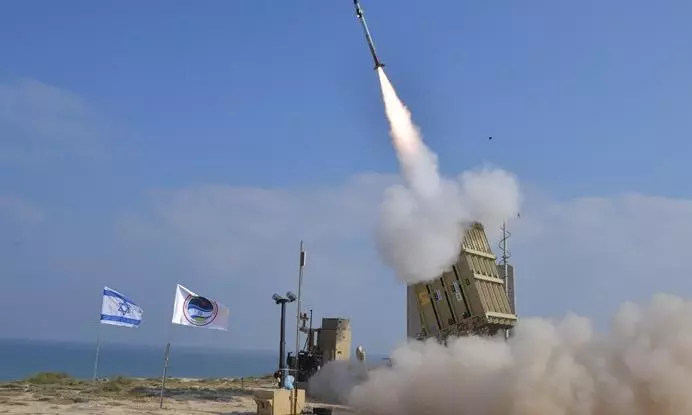
Explained: What's Israel’s Iron Dome air defence system which intercepted Hamas rockets?
With Israel ‘at war’ with Hamas, its famed Iron Dome system, which can intercept and destroy missiles or rockets mid-air, is in the news again

Hamas, a Palestinian militant organisation working out of the Gaza Strip, launched an audacious multi-front attack on Israel in the early morning hours on Saturday (October 7), a Jewish holiday. The attack, backed by a barrage of 5000 rockets fired within 20 minutes from the Gaza Strip, took Israelis by surprise which left 250 dead and 1500 wounded even as Hamas fighters went deep into many Israeli towns and took scores of soldiers and civilians hostage, according to media reports.
As air raid sirens pierced through the early-morning calm, the Israeli defence forces activated their famed Iron Dome system to counter the attack and nullify the rockets mid-air. The blitzkrieg the Iron Dome system created in the air brought the system back into the limelight again.
Here is all about the Israeli Iron Dome system, what it is and how it works:
What is Iron Dome?
Developed by Rafael Advanced Defense Systems and Israel Aerospace Industries, Iron Dome is a mobile, land-based air missile defence system that can intercept and destroy incoming rockets, mortars, artillery fire and UAV. The system can successfully intercept multiple short-range rockets at a time. Designed to intercept missiles with a range of about 40 miles or less, the Iron Dome is a mobile system and can thus be moved anywhere to suit defence needs.
How does the Iron Dome work?
The system, which has become the mainstay of the Israeli defence forces ever since it came into being in 2011, has the following components:
MMR Radar Detection and Fire Control: This component detects the route of an incoming rocket over Iron Dome batteries. After detecting the trajectory of the incoming rocket, the radar relays the information to the weapons control system or Command and Control unit.
Command and Control Centre: The centre rapidly analyses the trajectory of incoming rockets, speed and landing area to intercept them in mid-air.
Launcher: The interceptor receives a command from the Command and Control unit to launch missiles to intercept the incoming rocket before it lands. The launcher fires a missile, which has 20 interceptor Tamir missiles, to neutralise the threat. A single battery has three to four such launchers.
For instance, if an incoming rocket is estimated to hit a populated area or a strategic installation, the launcher automatically fires the missile and destroys it in mid-air.
Israel has 10 such Iron Dome systems, according to media reports, and the system has 90 per cent success rate against enemy strikes. The system has made over 2,000 intercepts to date.
How did it come into being?
Israel began to develop the Iron Dome system after the Lebanon conflict in 2006 during which Hezbollah fired thousands of rockets in northern areas including the city of Haifa. The attack prompted Israel to develop its own air defence system and the project was launched in 2007.
According to the Israel Missile Defense Organisation (IMDO), the system was developed in collaboration with the United States. “The United States was a partner in the development of the Iron Dome system and continues to develop the system with Israel today. IMDO leads the development of the Iron Dome, with Rafael Advanced Defense Systems as the main contractor, together with Elta of the Israel Aerospace Industries (IAI), and mPrest of Rafael,” says the IMDO.
How effective is the system?
The Iron Dome system became operational in 2011 and intercepted a rocket fired from the Gaza Strip at the Israeli city of Ashkelon. “The system has successfully prevented countless rockets from hitting Israeli communities,” says the IMDO, with a success rate of 90 per cent.
Israel has been upgrading the system consistently to intercept salvos of rockets, missiles and UAVs and neutralise them mid-air. During the two-week-long conflict in May 2021, over 4,500 rockets were fired over Israel but the country was able to neutralise 90 per cent of the incoming salvos with the help of the Iron Dome system, according to media reports.
However, in their latest attack, the Palestinians seem to have outfoxed both Israel and the Iron Dome system.

